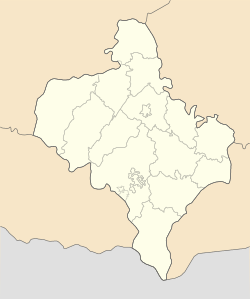Verkhovyna
Verkhovyna (Ukrainian: Верховина; before 1962, Ukrainian: Жаб'є, Polish: Żabie) is an urban-type settlement located in Ivano-Frankivsk Oblast in western Ukraine. Verkhovyna serves as the administrative center of Verkhovyna Raion. Population: 5,857 (2016 est.)[1].
Verkhovyna Верховина | |
|---|---|
Town | |
Skyline of Verkhovyna | |
 Verkhovyna Location of Verkhovyna, Ukraine  Verkhovyna Verkhovyna (Ukraine) | |
| Coordinates: 48°09′06″N 24°48′49″E | |
| Country | |
| Oblast | |
| Raion | Verkhovyna |
| First mentioned | 1424 |
| Area | |
| • Total | 51.80 km2 (20.00 sq mi) |
| Population (2016) | |
| • Total | 5,857 |
| • Density | 104.48/km2 (270.6/sq mi) |
| Area code(s) | +380 3432 |
It was originally established as Żabie in 1424.[2][3]
The town is located in the Hutsul region of the Carpathian Mountains called Pokuttya, upon the Cheremosh River, a tributary of the Prut. Verkhovyna is currently an important tourist center in Ukraine. The town's name means "highland place."
In 1919-1939, Żabie belonged to Poland and was located in the Kosów Powiat (county) of the Stanisławów Voivodeship. During those years, it was one of the main tourist centers of the country, attracting people from as far away as England. It was also the biggest rural community in Poland (in terms of territory).
There is an interesting Orthodox church, a Hutsul museum and a Polish cemetery with monuments of soldiers of the Polish Border Patrol who died while protecting the pre-1939 border. Another important attraction in Verkhovyna is the Museum of Musical Instruments and Hutsuls Lifestyle founded by Roman Kumlyk.
Gallery
 Carpathians in Verkhovyna
Carpathians in Verkhovyna.jpg) Church in Verkhovyna
Church in Verkhovyna Film museum
Film museum- Sanatoria in Verkhovyna
 Hutsul museum
Hutsul museum- Verkhovyna district council
Climate
The climate in Verkhovyna is a mild to warm summer subtype (Köppen: Dfb) of the humid continental climate.
| Climate data for Verkhovyna | |||||||||||||
|---|---|---|---|---|---|---|---|---|---|---|---|---|---|
| Month | Jan | Feb | Mar | Apr | May | Jun | Jul | Aug | Sep | Oct | Nov | Dec | Year |
| Daily mean °C (°F) | −5.1 (22.8) |
−3.2 (26.2) |
1.3 (34.3) |
7.4 (45.3) |
12.5 (54.5) |
15.5 (59.9) |
16.9 (62.4) |
16.6 (61.9) |
12.9 (55.2) |
7.6 (45.7) |
2.2 (36.0) |
−2.4 (27.7) |
6.9 (44.4) |
| Average precipitation mm (inches) | 38 (1.5) |
36 (1.4) |
38 (1.5) |
60 (2.4) |
88 (3.5) |
109 (4.3) |
104 (4.1) |
81 (3.2) |
54 (2.1) |
41 (1.6) |
42 (1.7) |
46 (1.8) |
737 (29.1) |
| Source: Climate-Data.org[4] | |||||||||||||
References
- "Чисельність наявного населення України (Actual population of Ukraine)" (PDF) (in Ukrainian). State Statistics Service of Ukraine. Retrieved 19 July 2016.
- Verkhovyna Raion's profile as Verkhovna Rada website
- Horse riding in Verkhovyna
- "Climate: Verkhovyna". Climate-Data.org. Retrieved 1 May 2014.